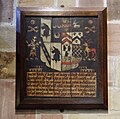Top Qs
Timeline
Chat
Perspective
Holy Cross Church, Woodchurch
Church in Merseyside, England From Wikipedia, the free encyclopedia
Remove ads
Holy Cross Church is in Woodchurch, an area of Birkenhead, Wirral, Merseyside, England. It is an active Anglican parish church in the diocese of Chester, the archdeaconry of Chester and the deanery of Birkenhead.[1] The church is recorded in the National Heritage List for England as a designated Grade II* listed building.[2]
Remove ads
Remove ads
History
The fabric of the nave originates from the 12th century.[3] However, the circular style graveyard suggests a pre-Norman date, possible Saxon or Romano-British. This early date is supported by the discovery of a portion of a 'Class D' Anglo-Saxon wheel cross at the grounds of the church in the late 19th or early 20th century and placed within the wall of the chancel within the church. The cross probably stood intact in the graveyard until the 17th century when many such crosses were destroyed by the Puritans [4] In the 14th century the south aisle, chancel and tower were added.[3] The south aisle was rebuilt in the 16th century and a south porch was added. Heavy diagonal buttresses were added to the tower in 1675. The vestry was built in 1766.[5] The north aisle by Hubert Worthington was added in 1964–65.[2]
Remove ads
Architecture
Summarize
Perspective
Exterior
The church is built in stone. The roofs are of slate with copper covering the latest additions to the church. Its plan consists of a nave with north and south aisles, a chancel, vestry and south porch. The tower is in two stages, the lower stage being very high. At the northwest and southwest corners of the tower are massive stepped buttresses. To its southeast is a square stair turret. Its top is embattled. In the porch is a shallow piscina[2] and grooves said to be caused by the sharpening of arrows.[3] The windows in the porch contain some medieval stained glass.[6][7] The north wall of the nave is Norman and the chancel inclines to the north.[6] Built into the wall of the chancel is a Saxon wheel cross.[3] The chancel also contains old stained glass.[7]
Interior
On the north wall of the chancel are three 17th-century wooden epitaph panels containing the coats of arms of local people painted by Randle Holme.[8] The wooden carved bench ends in the chancel date from the 15th century. At the back of the church is a charity board dated 1741.[3] On the west wall are old bread shelves dated 1641 and 1670.[8] On the west wall of the south aisle are the remnants of a Jesse window by Kempe which was damaged by a bomb in 1941 and restored in 1945.[3] The octagonal font dates from the late 15th century and includes carvings of angels and scenes from the Passion. The floor contains some medieval encaustic tiles.[6] The rood screen, designed by Bernard A. Miller and carved by Alan Durst, was added in 1934. The south window of the chancel is by Kempe, and is dated 1875. A processional cross dated 1937 was carved in ivory by Alan Durst. In the chancel is a monument by W. Spence to Margaret Hughes who died in 1802.[9] The parish registers begin in 1571.[6] There is a ring of eight bells which were cast in 1971 by the Whitechapel Bell Foundry.[10] It is said to be one of the lightest rings in Britain.[3]
- Chancel showing bench ends
- Hocknell epitaph panel
- Alan Durst's rood screen
- Kempe's reconstructed Jesse window
- East window
Remove ads
Organ Specification
Summarize
Perspective
The organ was built in 1938 by Rushworth and Dreaper and rebuilt in 1997 by the same firm.[citation needed] It is an electronic extension organ, with 2 manuals and a concave radiating pedal board. There are also confusingly 2 boxes, meaning that the entire instrument is boxed. Listed below are the list of stops, which on the instrument are tabbed, along with a list of where stops have been used again, and which box controls the stop. The number in brackets refers to the stop number below which from which it is borrowed.[citation needed]
See also
References
Further reading
External links
Wikiwand - on
Seamless Wikipedia browsing. On steroids.
Remove ads







